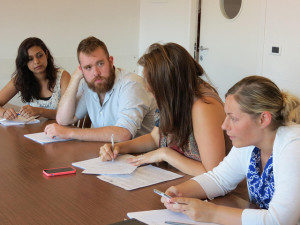by Punya Bagga, India/Canada
As we moved into our third week of the symposium, we were introduced to a form of conflict resolution, or more appropriately, a different way of waging conflict: nonviolent action. Hailing from the nation whose father is credited with coining the terminology associated with the field of nonviolent action, Mahatma Gandhi, I am well aware of the power of movements that have as their only weapon the resilience of the human spirit in the face of oppression.
One of our speakers for the day and a promoter of Gandhian values, Dr. Mary Elizabeth King, entered this  sphere at the age of twenty-two as a civil rights activist alongside the likes of Dr. Martin Luther King, Jr. She currently acts as the academic advisor of the International Centre on Nonviolent Action (ICNC). In our lecture, I was surprised to hear nonviolent movements portrayed as strategically planned alternative ways of waging conflict. This notion veers from the typical understanding of a nonviolent movement as a spontaneous eruption of repressed grievances following a random event.
sphere at the age of twenty-two as a civil rights activist alongside the likes of Dr. Martin Luther King, Jr. She currently acts as the academic advisor of the International Centre on Nonviolent Action (ICNC). In our lecture, I was surprised to hear nonviolent movements portrayed as strategically planned alternative ways of waging conflict. This notion veers from the typical understanding of a nonviolent movement as a spontaneous eruption of repressed grievances following a random event.
The ease of civilian participation in nonviolent action due to reduced legal and physical risks may provide strength in numbers as masses can be easily mobilized but, the ICNC made clear that this had little bearing on the success of the movement. Civil resistance is inherently asymmetrical in nature and so it is necessary for nonviolent movements to be organized and resilient, having above all a grand strategy that employs diverse tactics of non-violent action (protests, marches, sit-ins, hunger-strikes, boycotts). The movement, moreover, must be developed in such a way that it can be redeveloped if it fails, that is, it must never demobilize completely.
As we delved into the history, successes and methods of waging non-violent action, Dr. King was asked to comment on the applicability of nonviolent action in the conflict between Israel and Hamas which has been flaring up outside of our safe classroom walls. The response caused discomfort in the room when it was suggested that Gazans take advantage of the asymmetrical power dynamic between Hamas and Israel by making use of nonviolent methods (such as hunger-strikes) to gain international sympathy for their cause and hopefully pressure for the cessation of violence. At the time, I was shocked at the proposition of going on a hunger-strike to prove worth to international support; I dare not speak for the emotions of my Gazan colleague who sat next to me. As I struggled through the day trying to come up with a rationale for this suggestion, I was compelled by another colleague, Choloe Chapple, to analyse Dr. King’s comment through the lens of non-violence.
In a grossly asymmetrical conflict, if the weaker party to a conflict chooses to either act violently or not act at all, and a third party (i.e. the international community) chooses silence, then we are left with the dilemma of the stronger party shaping the narrative. The use of violent methods by an organization/group of people that is struggling then justifies increased violence and oppression against that very group to control the struggle at large. Violence begets more violence and, as iterated by Dr. King, the cycle of revenge and retaliation never ends.
 Throughout history nonviolent movements have surfaced in the face of acute suffering. It is perhaps too much to ask those who are suffering to pursue this transcendent path of waging conflict, but I cannot deny that there is a huge possibility such action will result in fewer casualties. I would be remiss not to emphasize that non-violent action seldom forms without a simultaneous or previously occurring violent movement with similar interests. However, even if non-violent action is not the golden solution to conflict resolution, we can appreciate that it may be the only bloodless solution we have in transforming the power-dynamic of an asymmetrical conflict– apart from miraculous diplomacy of course.
Throughout history nonviolent movements have surfaced in the face of acute suffering. It is perhaps too much to ask those who are suffering to pursue this transcendent path of waging conflict, but I cannot deny that there is a huge possibility such action will result in fewer casualties. I would be remiss not to emphasize that non-violent action seldom forms without a simultaneous or previously occurring violent movement with similar interests. However, even if non-violent action is not the golden solution to conflict resolution, we can appreciate that it may be the only bloodless solution we have in transforming the power-dynamic of an asymmetrical conflict– apart from miraculous diplomacy of course.
Additionally, my homeland India may have gained independence thanks in part to Gandhi’s nonviolent efforts, but such action does not always work. India’s 2011 nonviolent anti-corruption movement led by the Gandhi-emulating leader Anna Hazare, who used consistent hunger-strikes rallying around him mass protests involving diverse classes, has mostly fizzled out.
If non-violent action can help shift the power-dynamic, I wonder how it can organize, unify, and strategize to combat structural violence in countries so large, diverse, and ostensibly democratic as India or the United States?

